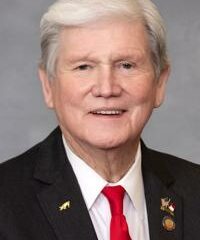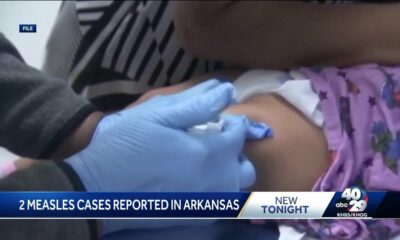Mississippi Today
With billions on the table for water infrastructure, small communities risk being left out to dry

Seth Petersen was at his grandmother’s funeral, and his phone wouldn’t stop ringing.
Three hours away in the village of Luck, Wisconsin, where he served as director of public works, there was an emergency. Petersen was getting calls repeatedly, asking for his expertise.
Petersen and two other employees were responsible for drinking water, wastewater, street maintenance, park and cemetery maintenance and picking up stray dogs, he said. The job never stopped.
“Seth, what the (expletive) are you doing?” his brother-in-law said to him as he came back to the family gathering from another call. “Why are you living like this?”
Petersen left that job at the end of last year. Now, he helps train water operators in small communities for the Wisconsin Rural Water Association.
Luck is not an outlier. In small and rural communities across the U.S., water system operators are stretched thin, covering around-the-clock responsibilities to keep water running safely and reliably despite aging and underfunded infrastructure.
The consequences of a water system falling behind have received the national spotlight, infamously in Flint, Michigan, and most recently in Jackson, Mississippi, where majority-Black communities bore the brunt of mismanagement and aging infrastructure.
Thousands of under-resourced systems risk a similar fate, and small water systems — defined by the EPA as serving fewer than 10,000 people, and making up more than 90% of the nation’s community water systems — are in a particularly precarious position.
Their staffing is often sparse and underpaid. Infrastructure, in many places, is crumbling and underfunded, and though there is a fresh infusion of federal money on the table, it’s a challenge to access.
The American Rescue Plan Act, Bipartisan Infrastructure Law and other programs represent a historic investment in the country’s water infrastructure, totaling billions of dollars.
But the total available funding, even after it’s all been doled out, still won’t be enough. One report from 2020 estimated that the U.S. would need to invest nearly $3.3 trillion in water and wastewater infrastructure projects between 2019 and 2039 to keep systems updated.
Many communities will also face increases in their water bills to keep up with infrastructure and staffing needs. Yet raising the price of water may prove unworkable in rural and historically-underinvested communities like Appalachia and the Mississippi Delta, some of the most impoverished in the country.
No one in the U.S. should have to worry about having safe drinking water, said Chris Groh, executive director of the Wisconsin Rural Water Association.
“But a town doesn’t take care of itself.”
Small community water systems falling behind
Over the last two decades, water systems in the ten states bordering the Mississippi River violated U.S. Environmental Protection Agency regulations for drinking water more than 438,000 times.
That figure includes thousands of instances of heightened levels of harmful chemicals in water each year. Nitrates, trihalomethanes and haloacetic acids, which have all been linked to various cancers and other health hazards, were top contaminants in the EPA’s violation data in 2022.
Nitrates are an indicator of agricultural runoff, common in rural areas. And trihalomethanes and haloacetic acids appear as byproducts of the water treatment process, when chlorine reacts with organic contents.
Addressing these issues can require expensive treatment technology. But in the last two decades, small and large utilities alike have reined in the number of violations.
However, an Ag and Water Desk analysis of EPA Safe Drinking Water Act violation data nationwide found small water systems have been slower to reduce their violations than larger systems. And these violations only represented those reported; there could be many more incidences of unreported issues.
In the ten states along the Mississippi River, both small and large water systems saw increases in violations newly reported during 2022. For small water systems, that increase was more significant.
And recent injections of federal infrastructure funding won’t be enough, she said. They’re not sustained funding, she added, and “the sad thing about it is: It still doesn’t catch us up.”
‘I don’t have a day off’
The working conditions that drove Petersen to leave his position in Luck are a trend reflected in small communities across the country.
“I don’t have a day off,” said Nathan Taylor, lead operator of a small water plant in Wax, Kentucky. The days he’s not on-duty, his phone is constantly ringing as issues come up at the plant, he said.
Ziegler pointed out a water operator she knows nearby in the Mississippi Delta, whose responsibilities span four different water districts — “a huge, huge area,” she said.
Water system operators serve as a first line of defense for a community’s public health, and must have working knowledge of chemistry for licensing tests.
Yet operator pay in many small communities is about neck-and-neck with wages at the local McDonald’s. Other trades, like construction, often pay far more.
“You can go swing a hammer for 25 bucks an hour,” said Petersen, in Wisconsin, “…and you can ice fish all winter.”
A workforce survey last year in Kentucky found water utilities in the state pay as low as $10 per hour for an entry level position, with an average closer to $18. But 72% of managers reported losing staff to better pay in another job opportunity or other, often larger utilities.
The water workforce nationally is also aging overwhelmingly. Seventeen million workers are expected to leave the industry in the next decade, Ziegler said, and bringing young people into the profession has proven challenging.
“We’re losing people,” she said, and “we’re not getting them back.”
Federal money on the table, if you can get it
Widespread water workforce shortages make accessing infrastructure funding an even bigger task for small water systems’ overworked staff, despite desperate needs.
And the application process for federal funds often looks very similar in a village of 1,000 or a city of half a million, according to Ziegler.
“It is extremely extensive,” she said. “Not just the application, but the amount of background documentation that you have to provide them. It takes… I would say, months, to get it together.”
Smaller systems are at an inherent disadvantage. Larger utilities, with more ratepayers and bigger budgets, often have experts on staff to go after competitive funding pots.
“Their applications are shiny,” Petersen said. “And they’re written by someone with a Master’s degree.”
During his tenure as director of public works, Petersen worked through the application process to access federal infrastructure funding for Luck’s streets. Even with help from a consultant and phone calls with the state, he described it as overwhelming.
“You don’t even know where to begin,” he said. “Things are this far behind.”
Luck didn’t get that money. And in cash-strapped communities, paying large sums for the help of consultants in applying for funding that isn’t guaranteed is a big gamble.
“Let’s just be honest. If they can’t afford to upgrade and maintain and operate their systems with the money they have,” Ziegler said, “do you think they have money left over to hire somebody, to pay somebody to put together this application…? They don’t.”
Poorer communities facing higher water bills
Without sustained infrastructure funding, communities in turn face a rising water rate. In many rural areas, it’s a bill they can’t afford.
In Martin County, Kentucky, where communities are built along snaking creeks and between the rolling mountains of Appalachia, residents still don’t trust the tap.
Decades of water district mismanagement, including chronic reports of discolored water and burdensome service shutoffs, eventually culminated in a state takeover. In 2020, authorities shifted control to Alliance Water Resources, a private firm, hoping to get the county’s water provisions on the right track.
At the peak of the crisis, the system’s aging water lines were leaking up to 90% of the water they were carrying, according to the estimates of Craig Miller, who now oversees the county’s water operations as division manager for the firm. For Martin County, that meant tens of millions of gallons of water going to waste every month.
In the years since the change in management, Martin County’s water system has made progress. In a recent stakeholder workgroup meeting, Miller reported improvements in water loss, as well as new hires and licensing for staff.
“There’s a good story here,” Miller said in the meeting. “But it is not over.”
Improvements came with a 24% rate increase, effective last year, piling onto already steep prices. More than a fifth of Martin County lives below the poverty line, according to recent census data.
“That’s a huge burden on our poorest people,” said Nina McCoy, an advocate with Martin County Concerned Citizens, in the workgroup meeting. She pointed out that local water rates are far higher than in wealthier Louisville, where median income is 50% higher than that of Martin County.
The region’s mountainous terrain piles onto water infrastructure challenges, said Lindell Ormsbee, a professor of civil engineering at the University of Kentucky who’s paid close attention to the state’s water system struggles. And as in many rural areas, there are miles of water lines for relatively few homes, compared to cities like Louisville.
In Eastern Kentucky, many counties have historically relied on taxing the coal industry to fund water and other infrastructure needs. As the coal industry has declined, that funding has dried up, Ormsbee said, turning the burden over to ratepayers.
Even if systems are able to access one-time federal infrastructure funding, once it’s spent, they’ll return back to current levels of funding. In small communities, Ziegler said, that just won’t be enough.
“They’re serving less affluent areas. They’re serving older populations on fixed incomes,” Ziegler said, citing high rates of poverty in the rural and disadvantaged communities of her state of Mississippi. “Their customers cannot afford to pay more.”
Connor Giffin is an environmental reporter for the Louisville Courier Journal and a corps member with Report for America. Kae Petrin contributed data reporting.
This story, published in partnership with the Mississippi Center for Investigative Reporting, part of Mississippi Today, is a product of the Mississippi River Basin Ag & Water Desk, an independent reporting network based at the University of Missouri in partnership with Report for America, funded by the Walton Family Foundation.
This article first appeared on Mississippi Today and is republished here under a Creative Commons license.
Mississippi Today
On this day in 1947, Jackie Robinson broke MLB color barrier
April 15, 1947

Jackie Robinson broke through the color barrier in Major League Baseball, becoming the first Black player in the 20th century.
Born in Cairo, Georgia, Robinson lettered in four sports at UCLA – football, basketball, baseball and track. After time in the military, he played for the Kansas City Monarchs in the Negro Leagues. After his success there, Dodgers general manager Branch Rickey signed Robinson, and the legendary baseball player started for Montreal, where he integrated the International League.
In addition to his Hall of Fame career, he was active in the civil rights movement and became the first Black TV analyst in Major League Baseball and the first Black vice president of a major American corporation.
In recognition of his achievements, Robinson was posthumously awarded the Presidential Medal of Freedom and the Congressional Gold Medal.
Major League Baseball retired his number “42,” which became the title of the movie about his breakthrough.
Ken Burns’ four-hour documentary reveals that Robinson did more than just break the color barrier — he became a leader for equal rights for all Americans.
This article first appeared on Mississippi Today and is republished here under a Creative Commons Attribution-NoDerivatives 4.0 International License.![]()
Mississippi Today
Mississippians highlight Black Maternal Health Week
Advocates and health care leaders joined lawmakers Monday morning at the Capitol to recognize Black Maternal Health Week, which started Friday.
The group was highlighting the racial disparities that persist in the delivery room, with Black women three times more likely to die of a pregnancy-related cause than white women.
“The bond between a mother and her baby is worth protecting,” said Cassandra Welchlin, executive director of the Mississippi Black Women’s Roundtable.
Rep. Timaka James-Jones, D-Belzoni, spoke about her niece Harmony, who suffered from preeclampsia and died on the side of the road in 2021 along with her unborn baby, three miles from the closest hospital in Yazoo City.
“It’s utterly important that stories are shared – but realize these are not just stories. This is real life,” she said.
The tragedy inspired James-Jones to become a lawmaker. She says she is working on gaining support to appropriate the funds needed to build a standalone emergency room in Belzoni.
But it isn’t just emergency medical care that’s lacking for some mothers. Mental health conditions are a leading cause of pregnancy-related deaths, defined as deaths up to one year postpartum from associated causes.
And more than 80% of pregnancy-related deaths are deemed preventable – making the issue ripe for policy change, advocates said.
“About 20 years ago, I was almost a statistic,” said Lauren Jones, a mother who founded Mom.Me, a nonprofit seeking to normalize the struggles of motherhood through community support. “I contemplated taking my life, I severely suffered from postpartum depression … None of my physicians told me that the head is connected to the body while pregnant.”
With studies showing “mounting disparities” in women’s health across the United States – and Mississippi scoring among the worst overall – more action is needed to halt and reverse the inequities, those at the press conference said.
The Mississippi Legislature passed four bills related to maternal health between 2018 and 2023, according to a study by researchers at the University of Mississippi Medical Center.
“How many times are we going to have to come before committees like this to share the statistics before the statistics become a solution?” Jones asked.
A bill that would require health care providers to offer postpartum depression screenings to mothers is pending approval from the governor.
Rep. Zakiya Summers, D-Jackson, the organizer of the press conference, commended the Legislature for passing presumptive eligibility for pregnant women this year. The policy will allow women to receive health care covered by Medicaid as soon as they find out they are pregnant – even if their Medicaid application is still pending. It was spearheaded by Rep. Missy McGee, R-Hattiesburg.
Summers also thanked Rep. Kevin Felsher, R-Biloxi, for pushing paid parental leave for state employees through the finish line this year.
Speakers emphasized the importance of focusing Black Maternal Health Week not just on mitigating deaths but on celebrating one of life’s most vulnerable and meaningful events.
“Black Maternal Health Week is a celebration of life, since Black women don’t often get those opportunities to celebrate,” said Nakeitra Burse, executive director of Six Dimensions, a minority women-owned public health research agency. “We go into our labor and delivery and pregnancy with fear – of the unknown, fear of how we’ll be taken care of, and just overall uncertainty about the outcomes.”
This article first appeared on Mississippi Today and is republished here under a Creative Commons Attribution-NoDerivatives 4.0 International License.![]()
Mississippi Today
Trump to appoint two Northern District MS judges after Aycock takes senior status
President Donald Trump can now appoint two new judges to the federal bench in the Northern District of Mississippi.
U.S. District Judge Sharion Aycock announced recently that she was taking senior status effective April 15. This means she will still hear cases as a judge but will have a reduced caseload.
“I have been so fortunate during my entire legal career,” Aycock said in a statement. “As one of only a few women graduating in my law school class, I had the chance to break ground for the female practitioner.”
A native of Itawamba County, Aycock graduated from Tremont High School and Mississippi State University. She received her law degree from Mississippi College, where she graduated second in her class.
Throughout her legal career, she blazed many trails for women practicing law and female jurists. She began her career as a judge when she was elected as a Mississippi Circuit Court judge in northeast Mississippi in 2002, the first woman ever elected to that judicial district.
She held that position until President George W. Bush in 2007 appointed her to the federal bench. After the U.S. Senate unanimously confirmed her, she became the first woman confirmed to the federal judiciary in Mississippi.
This makes Aycock the second judge to take senior status in four years. U.S. District Judge Michael Mills announced in 2021 that he was taking senior status, but the U.S. Senate still has not confirmed someone to replace him.
President Joe Biden appointed state prosecutor Scott Colom to fill Mills’ vacancy in 2023. U.S. Sen. Roger Wicker approved Colom’s appointment, but U.S. Sen. Cindy Hyde-Smith blocked his confirmation through a practice known as “blue slips,” where senators can block the confirmation of judicial appointees in their home state.
This means President Trump will now have the opportunity to appoint two federal judges to lifetime appointments to the Northern District. U.S. District Judge Debra Brown will soon be the only active federal judge serving in the district. Aycock, Mills, and U.S. District Judge Glen Davidson will all be senior-status judges.
Federal district judges provide crucial work to the federal courts through presiding over major criminal and civil trials and applying rulings from the U.S. Supreme Court and the U.S. Court of Appeals in the local districts.
This article first appeared on Mississippi Today and is republished here under a Creative Commons Attribution-NoDerivatives 4.0 International License.![]()
-

 News from the South - Missouri News Feed6 days ago
News from the South - Missouri News Feed6 days agoLocals react to Cara Spencer winning mayoral race
-

 News from the South - Arkansas News Feed6 days ago
News from the South - Arkansas News Feed6 days agoArkansas State Police launches new phone-free campaign
-

 News from the South - North Carolina News Feed6 days ago
News from the South - North Carolina News Feed6 days agoProposal: Farm property tax break on solar from 80% to zero | North Carolina
-

 News from the South - Arkansas News Feed4 days ago
News from the South - Arkansas News Feed4 days agoMeasles cases confirmed in Arkansas children after travel exposure
-

 Mississippi Today7 days ago
Mississippi Today7 days agoWard 6 council candidates face the image of south Jackson versus the reality
-

 News from the South - Missouri News Feed5 days ago
News from the South - Missouri News Feed5 days agoSleeping 14-year-old critically injured by bullet in Ferguson home; father flees scene
-

 News from the South - Alabama News Feed4 days ago
News from the South - Alabama News Feed4 days agoImpacts of Overdraft Fees | April 11, 2025 | News 19 at 10 p.m.
-

 News from the South - North Carolina News Feed6 days ago
News from the South - North Carolina News Feed6 days agoTax Day of April 15 is essentially May 1 in North Carolina | North Carolina





















































